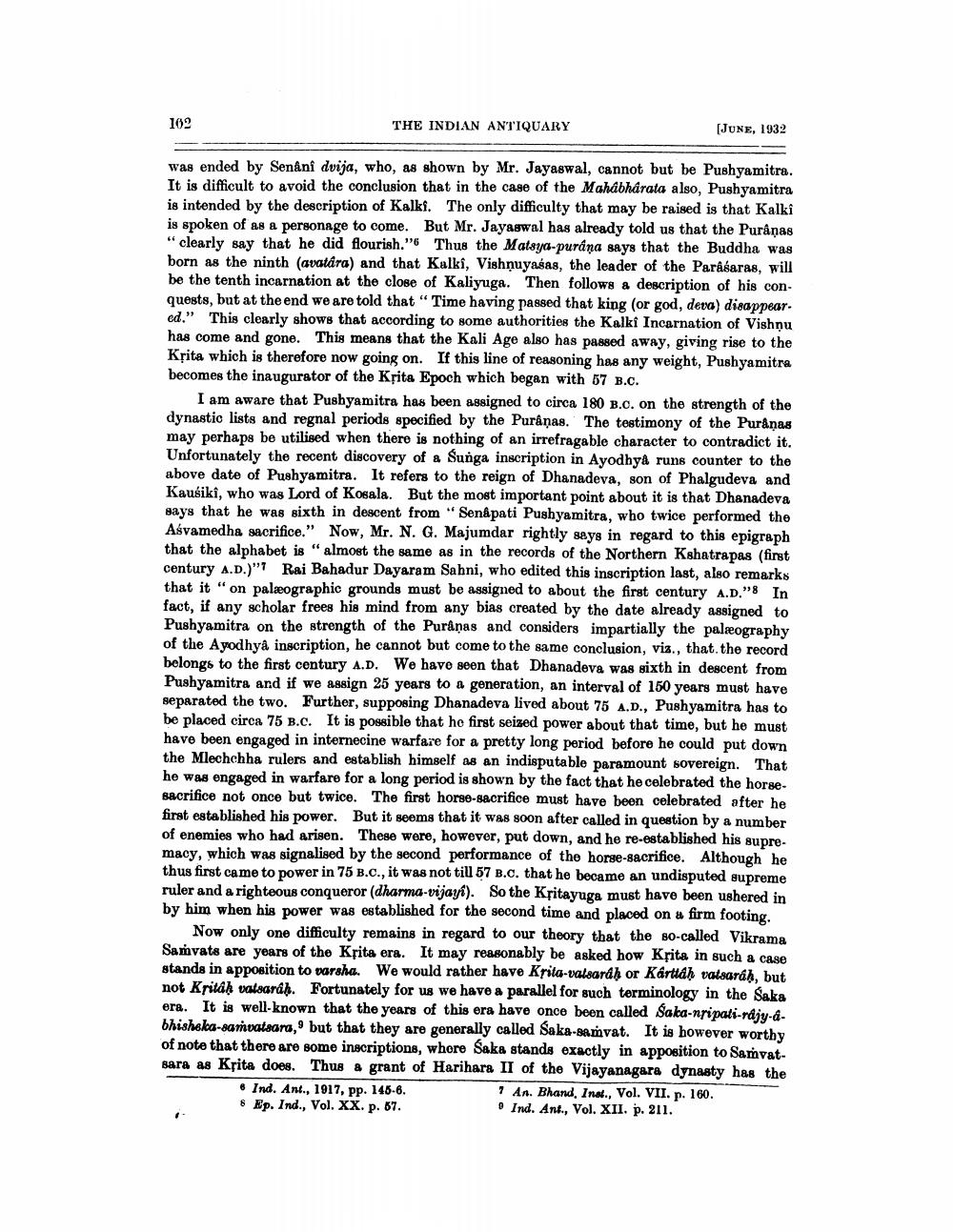________________
102
THE INDIAN ANTIQUARY
(JUNE, 1932
was ended by Senani dvija, who, as shown by Mr. Jayaswal, cannot but be Pushyamitra. It is difficult to avoid the conclusion that in the case of the Mahabharata also, Pushyamitra is intended by the description of Kalki. The only difficulty that may be raised is that Kalki is spoken of as a personage to come. But Mr. Jayagwal has already told us that the Puranas "clearly say that he did flourish." Thus the Matsya-purana says that the Buddha was born as the ninth (avatara) and that Kalki, Vishnuyasas, the leader of the Parasaras, will be the tenth incarnation at the close of Kaliyuga. Then follows a description of his conquests, but at the end we are told that "Time having passed that king (or god, deva) disappear. ed." This clearly shows that according to some authorities the Kalki Incarnation of Vishnu has come and gone. This means that the Kali Age also has passed away, giving rise to the Krita which is therefore now going on. If this line of reasoning has any weight, Pushyamitra becomes the inaugurator of the Kșita Epoch which began with 67 B.C.
I am aware that Pushyamitra has been assigned to circa 180 B.C. on the strength of the dynastic lists and regnal periods specified by the Puranas. The testimony of the Puranas may perhaps be utilised when there is nothing of an irrefragable character to contradict it. Unfortunately the recent discovery of a Sunga inscription in Ayodhya runs counter to the above date of Pushyamitra. It refers to the reign of Dhanadeva, son of Phalgudeva and Kausiki, who was Lord of Kosala. But the most important point about it is that Dhanadeva says that he was sixth in descent from "Senåpati Pushyamitra, who twice performed the Ašvamedha sacrifice." Now, Mr. N. G. Majumdar rightly seys in regard to this epigraph that the alphabet is "almost the same as in the records of the Northern Kshatrapas (first century A.D.)" Rai Bahadur Dayaram Sahni, who edited this inscription last, also remarks that it "on palæographic grounds must be assigned to about the first century A.D." In fact, if any scholar frees his mind from any bias created by the date already assigned to Pushyamitra on the strength of the Puranas and considers impartially the palæography of the Ayodhya inscription, he cannot but come to the same conclusion, viz., that the record belongs to the first century A.D. We have seen that Dhanadeva was sixth in descent from Pushyamitra and if we assign 25 years to a generation, an interval of 150 years must have separated the two. Further, supposing Dhanadeva lived about 75 A.D., Pushyamitra has to be placed circa 75 B.C. It is possible that he first seized power about that time, but he must have been engaged in internecine warfare for a pretty long period before he could put down the Mlechchha rulers and establish himself as an indisputable paramount sovereign. That he was engaged in warfare for a long period is shown by the fact that he celebrated the horsesacrifice not once but twice. The first horse-sacrifice must have been celebrated after he first established his power. But it seems that it was soon after called in question by a number of enemies who had arisen. These were, however, put down, and he re-established his supremacy, which was signalised by the second performance of the horse-sacrifice. Although he thus first came to power in 75 B.C., it was not till 57 B.c. that he became an undisputed supreme ruler and a righteous conqueror (dharma-vijaył). So the Ksitayuga must have been ushered in by him when his power was established for the second time and placed on a firm footing.
Now only one difficulty remains in regard to our theory that the so-called Vikrama Samvats are years of the Krita era. It may reasonably be asked how Krita in such a case stands in apposition to varsha. We would rather have Krita-valsardh or Kartidh vatsaráh, but not Kritäh vatsard). Fortunately for us we have a parallel for such terminology in the Saka era. It is well-known that the years of this era have once been called Saka-nsipati-rajy-dbhisheka-samvatsara, but that they are generally called Saka-saṁvat. It is however worthy of note that there are some inscriptions, whore Saka stands exactly in apposition to SamvatBara as Krita does. Thus & grant of Harihara II of the Vijayanagara dynasty has the & Ind. Ant., 1917, pp. 146-6.
An. Bhand. Inst., Vol. VII. p. 160. 8 Ep. Ind., Vol. XX. p. 67.
. Ind. Ant., Vol. XII. p. 211.




